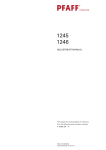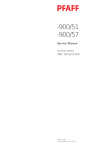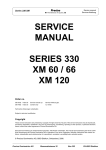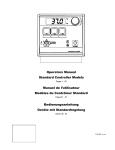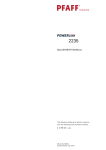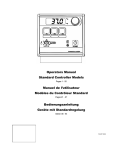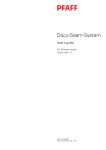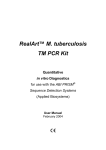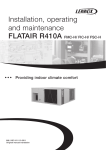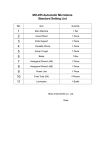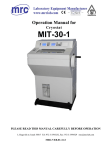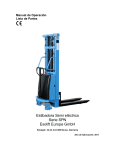Download Service Manual for the series 910 and 930
Transcript
-900/51 Service Manual for the series 910 and 930 296-12-18 210 Justieranleitung engl. 11.98 At the time of printing, all information and illustrations contained in this document were up to date. Subject to alteration! The reprinting, copying or translation of PFAFF Service Manuals, whether in whole or in part, is only permitted with our previous agreement and with written reference to the source. G.M. PFAFF Aktiengesellschaft Postfach 3020 D-67653 Kaiserslautern Königstr. 154 D-67655 Kaiserslautern Editing / Illustration PFAFF Abtlg. TES Table of Contents Contents ............................................................................... Chapter - Page 1 1.01 1.02 1.03 Safety ........................................................................................................................ 1 General notes on safety ............................................................................................. 1 Safety symbols .......................................................................................................... 1 Danger ....................................................................................................................... 1 2 2.01 2.02 2.03 2.04 2.05 2.06 2.07 2.08 2.09 2.10 2.11 2.12 2.13 2.14 2.15 2.16 Adjustment ............................................................................................................... 2 - 1 Notes on adjusting ..................................................................................................... 2 - 1 Tools, gauges and other accessories ......................................................................... 2 - 1 Abbreviations ............................................................................................................. 2 - 1 Work symbols ............................................................................................................ 2 - 1 Check and adjustment aid .......................................................................................... 2 - 2 Pre-adjusting the control cam .................................................................................... 2 - 3 Roller lever ................................................................................................................. 2 - 4 Pawl ........................................................................................................................... 2 - 5 Engaging solenoid ...................................................................................................... 2 - 6 Release lever ............................................................................................................. 2 - 7 Engaging lever ........................................................................................................... 2 - 8 Thread catcher position and cutting test .................................................................... 2 - 9 Control cam (final adjustment) and retaining spring ................................................... 2 - 10 Needle thread tension release ................................................................................... 2 - 11 Removing and refitting control unit ............................................................................ 2 - 13 Synchronizer .............................................................................................................. 2 - 14 - 1 1 2 2 Safety 1 Safety 1.01 General notes on safety ● This machine must only be operated by adequately trained operators and only after having completely read and understood the Instruction Manual! ● All Notes on Safety and Instruction Manuals of the motor manufacturer are to be read before operating the machine! ● The Danger and Safety Instructions on the machine itself are to be followed! ● The machine must be used only for the purpose for which it is intended and must not be operated without its safety devices. Observe all relevant safety regulations! ● When exchanging sewing tools (e.g. needle, presser foot, needle plate, feed dog and bobbin), when threading, when the workplace is left unattended and during servicing, the machine must be disconnected from the mains by switching off the on/off switch or by removing the plug from the mains! ● Daily servicing work must be carried out only by appropriately trained persons! ● Repairs and special maintenance work must only be carried out by technicians or persons with appropriate training! ● For service or repair work on pneumatic systems the machine must be disconnected from the compressed air supply. The only exceptions to this are adjustments and function checks made by appropriately trained personnel! ● Work on the electrical equipment must be carried out only by electricians or appropriately trained personnel! ● Work is not permitted on parts and equipment which are connected to the power supply! Exceptions to this are contained in the regulations EN 50110! ● Modifications and alterations to the machine must only be carried out under observance of all the relevant safety regulations! ● Only spare parts which have been approved by us are to be used for repairs! We expressly point out that any replacement parts or accessories which are not supplied by us have not been tested and approved by us. The installation and/or use of any such products can lead to negative changes in the structural characteristics of the machine. We shall not be liable for any damage which may be caused by non-original parts! 1-1 Safety 1.02 Safety symbols Danger! Points to be observed. Danger of injury to operating and specialist personnel! 1.03 Danger Do not reach into the sewing area while sewing! Danger of injury caused by needle! Do not leave any objects on the table or near the needle plate while carrying out adjusting work. Objects can become jammed or be slung away! Danger of injury! In order to adjust this device, the machine must be tilted to the back. Use both hands when returning the machine to an upright position! Danger of crushing between sewing head and table top! 1-2 Adjustment 2 Adjustment On the PFAFF 918, 937, 938 and 939 no c-clamps may be attached to the needle bar as this would damage the special coating on the needle bar. 2.01 Notes on adjusting All adjustments in these adjustment instructions are based on a completely assembled machine and must only be carried out by trained specialists. Covers on the machine which have to be removed and replaced for checks and adjustment work are not mentioned. 2.02 Tools, gauges and other accessories ● Screwdrivers with blade width from 2 to 10 mm ● Wrenches (spanners) with jaw width from 7 to 14 mm ● Allan keys from 1.5 to 6 mm ● Metal rule, Part No. 08-880 218-00 ● Blocking pin (5 mm diameter), Part No. 13-030 341-05 ● Sewing thread and test material 2.03 Abbreviations tdc = top dead center bdc = bottom dead center 2.04 Work symbols Note, information Servicing, repair, adjustment, maintenance 2-1 Adjustment 2.05 Check and adjustment aid By blocking with holes 1 - 4 the required needle bar positions can be fixed exactly. 1 5 2 4 3 1 5 2 4 3 Fig. 2 - 01 ● Turn the balance wheel until the needle bar has approximately reached the required position. ● Place the 5 mm blocking pin in the appropriate hole and put pressure on it. ● Turn the balance wheel forwards and backwards a little until the blocking pin moves into the slot in the crank behind the bearing plate, thus blocking the machine. Hole 1 Hole 2 = = 2.0 mm after the bottom dead center of the needle bar (2.0 past tdc) Top dead center of the needle bar (tdc) Hole 3 Hole 4 = = 0.25 mm after the top dead center of the needle bar (0.25 past bdc) 1.0 mm after the top dead center of the needle bar (1.0 mm past tdc) 2-2 Adjustment 2.06 Pre-adjusting the control cam Requirement With the needle bar at tdc (hole 2): 1. the beginning of the highest point of the lobe of control cam 1 must be underneath the point of pawl 2, 2. the right hand side of the lobe must be flush with pawl 2. 1 2 5 6 7 6 5 % 4V =4 ED 2 4 2 1 3 837-14-44 Fig. 2 - 02 ● Unscrew screw 3 and remove retaining spring 4 together with the cover washer. ● Loosen screws 5 and 6. ● Turn control cam 1 in accordance with requirement 1 and position it in accordance with requirement 2. ● Tighten screws 5. ● Push retaining collar 7 onto control cam 1 and tighten screws 6. Retaining spring 4 stays removed for the following adjustments. 2-3 Adjustment 2.07 Roller lever Requirement With the needle bar 2.0 past bdc (hole 1): 1. the roller of roller lever 1 must fall lightly into control cam 2 when roller lever 1 is lightly tapped 1 2 5 3 7 4 6 % V 24 ED =4 2 1 Fig. 2 - 03 37-14-45 ● ● ● ● ● ● Loosen screws 3 and 4. Put pressure on rock shaft 5 to the right. Move roller lever 1 in accordance with the requirement. Tighten screw 3. Loosen screw 6 and position the flat of retaining collar 7 parallel to the bedplate. Tighten screw 6. Screw 4 remains unscrewed for further adjustments. 2-4 Adjustment 2.08 Pawl Requirement With the thread trimmer in resting position there must be a clearance of 0.3 mm between pawl 1 and the largest eccentricity of the lobe on control cam 2. 2 1 % V 24 0.3 mm ED =4 1 2 3 4 3 37-14-46 Fig. 2 - 04 ● Position the largest eccentricity of the lobe on control cam 2 underneath pawl 1. ● Loosen screw 4. ● Position pin 3 in accordance with the requirement. ● Tighten screw 4. 2-5 Adjustment 2.09 Engaging solenoid Requirement With the needle bar 2.0 past bdc (hole 1) there must be a clearance of 0.2 to 0.3 mm between engaging lever 2 and pawl 1 when the engaging solenoid is active. 3 4 % V 24 ED =4 1 2 0.2 m 0.3 m 37 14 47 Fig. 2 - 05 ● Position the needle bar 2.0 after bdc (hole 1). ● Activate engaging lever 2 manually until pawl 1 drops into place. ● Loosen screw 4. ● Press the solenoid plunger as far as possible into the solenoid housing 3 and move solenoid housing 3 and the cutout arm in accordance with the requirement. ● Tighten screw 4. 2-6 Adjustment 2.10 Release lever Requirement With the needle bar 2.0 after bdc (hole 1) there must be a clearance of 0.2 mm between the roller of roller lever 1 and the base of control cam 2 with the engaging lever active. 5 4 % V 24 =4 ED 3 0.2 mm 1 4 3 2 837-14-48 Fig. 2 - 06 ● Position the needle bar 2.0 after bdc (hole 1). ● Activate engaging lever 3 manually. ● Press roller lever 1 down to the base of control cam 2. ● Position lever 4 on engaging lever 3 in such a way that there is a clearance of 0.2 mm between roller lever 1 and the base of control cam 2. Lever 4 must be touching roller lever 1 from the side. ● Tighten screw 5. 2-7 Adjustment 2.11 Engaging lever Requirement With the needle bar at tdc and the thread trimmer in resting position, there must be a clearance of 0.3 to 0.5 mm between the roller of roller lever 1 and the external diameter of control cam 2. 3 % V 24 ED =4 4 0.3 - 0.5 mm 1 2 4-49 Fig. 2 - 07 ● Loosen nut 4. ● Turn screw 3 in accordance with the requirement. ● Tighten nut 4. 2-8 Adjustment 2.12 Thread catcher position and cutting test Requirement With the thread trimmer in resting position the edge of thread trimmer 1 must be flush with the edge of bracket 2. 5 1 3 2 5 4 6 14-50 Fig. 2 - 08 ● Loosen nuts 4 (left and right-handed threads). ● Turn connecting rod 3 in accordance with the requirement and tighten nuts 4. ● For the cutting test disengage the connecting rod, loosen screws 5 and remove bracket 2. ● Adjust the cutting pressure by turning screw 6. ● Insert bracket 2 in such a way that its edge is flush with the edge of the bedplate. ● Tighten screws 5 and replace the connecting rod. 2-9 Adjustment 2.13 Control cam (final adjustment) and retaining spring Requirement 1. with the end of thread guard 1 at the height of the right edge of bobbin case position finger 2, thread catcher 3 must begin its forwards movement. 2. With the thread trimmer in resting position there must be a clearance of 0.5 mm between retaining spring 7 and roller lever 8. 5 4 6 3 5 % V 24 =4 ED 0.5 mm 8 7 1 2 9 4-51 Fig. 2 - 09 ● Position the needle bar at bdc. ● Activate the engaging lever. ● Loosen screws 5. ● Move control cam 4 in accordance with requirement 1 and position retaining collar 6 so that it is touching. ● Tighten screws 5. ● Fit retaining spring 7 together with the cover and tighten screws 9 lightly. ● Push retaining spring 7 upwards as far as possible and align it in accordance with requirement 2. ● Tighten screws 9. 2 - 10 Adjustment 2.14 Needle thread tension release Requirement 1. With hand lever 4 raised, the clearance between the tension disks must be 0.5 mm. 2. With the rock shaft 6 in its neutral position there must be a clearance of 0.5 mm between trip 8 and release cone 9. 3. With trip 8 at the highest point of release cone 9, the tension disks must be at least 0,5 mm apart. 4. With the needle trimmer in resting position and the presser foot on the needle plate the tension must be fully effective. 10 11 3 1 2 5 0.5 mm 9 0.5 mm 4 7 6 8 Fig. 2 - 10 ● Loosen screws 1, 2 and 3. ● Lift hand lever 4. ● Adjust the clearance between the tension disks in accordance with requirement 1 by turning hollow shaft 5. Clamp a screwdriver in hollow shaft 5 to turn it. ● Tighten screw 3. ● Bring the rock shaft 6 to its starting position. 2 - 11 Adjustment ● Loosen nut 7. ● Adjust the clearance between trip 8 and release cone 9 in accordance with requirement 2. ● Tighten nut 7. ● Position the feed dog underneath the needle plate and bring the presser foot to rest on the needle plate. ● Press clamp piece 10 upwards. ● Tighten screw 2 taking care to ensure that hollow shaft 5 does not have any end play. ● Engage the thread trimmer manually. The presser foot must be lowered. ● Turn the balance wheel until trip 8 is at the highest point of release cone 9. ● Adjust the clearance between the tension discs in accordance with requirement 4 by turning the tension release shaft (accessible through hollow shaft 5 using a screwdriver). ● Press crank 11 upwards and tighten screw 1. ● Lightly grease release cone 9. ● Carry out a check according to the requirement. Fine adjustment of the clearence between the tension disks can made on eccentric pin 12 after loosening nut 13. 13 12 2 - 12 Adjustment 2.15 Removing and refitting control unit 5 4 6 3 2 7 % V 24 ED =4 4 1 Fig. 2 - 11 ● To remove the control unit, pull plug 1 out of the socket of the motor control plate or the control box. ● Remove circlip 2 and disconnect connecting rod 3. ● Disconnect the ball joints of connecting rod 7 from the studs on the cutting and control unit and remove the complete control unit. ● To refit the control unit, bring the needle bar to the needle rise position. ● Fit connecting rod 3. ● Replace the control unit and lightly tighten screws 4. ● Attach circlip 2. ● Bring needle bar to bdc. ● Activate the engaging lever manually so that roller lever 5 falls into control cam 6. ● Align the control unit in such a way that the roller of roller lever 5 is positioned in the middle of the cutout in control cam 6. ● Tighten retaining screws 4. ● Fit connecting rod 7 and carry out a manual function-test. ● If the engaging lever is not released, realign the control unit. 2 - 13 Adjustment 2.16 Synchronizer Requirement 1. When sewing is stopped, the machine must position approx. 4 - 5 mm past the bdc of the needle bar. 2. After trimming the thread the machine must position at the tdc of the take up lever. ● For adjustment see the instruction manual of the motor manufacturer. 2 - 14 G.M. PFAFF Aktiengesellschaft Postfach 3020 D-67653 Kaiserslautern Königstr. 154 D-67655 Kaiserslautern Telefon: (0631) 200-0 Telefax: (0631) 172 02 Telex: 45753 PFAFF D Gedruckt in der BRD Printed in Germany Imprimé en R.F.A. Impreso en la R.F.A.





















